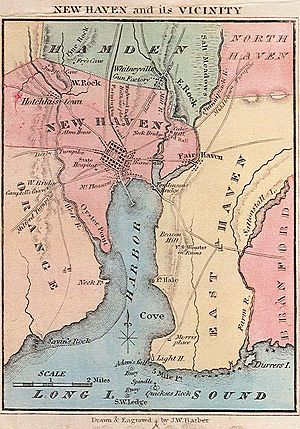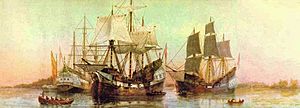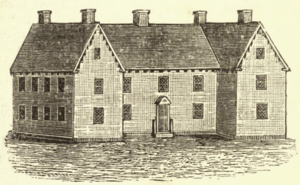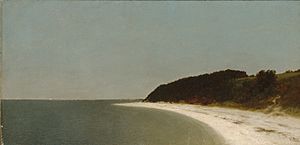Theophilus Eaton facts for kids
Theophilus Eaton (around 1590 – January 7, 1658) was a wealthy merchant and a leader who helped start two important colonies in America: the Massachusetts Bay Colony and the New Haven Colony. He was also the first Governor of the New Haven Colony in Connecticut. His brother, Nathaniel Eaton, was the first headmaster of Harvard University.
Contents
Early Life and Family
Theophilus Eaton was born in Stony Stratford, England, around 1590. His father was a church leader. Theophilus first married Grace Hiller. They had a daughter named Mary and a son named Samuel. Grace passed away later.
In 1625, Theophilus married Anne Yale, whose father was a bishop. Theophilus and Anne had three children: Theophilus Jr., Hannah, and Elizabeth. Their home was busy, raising eight children in total. This included their own three, Theophilus's children Mary and Samuel, and Anne's three children from her first marriage: Anne, David, and Thomas Yale.
Notable Family Members
Many of Theophilus Eaton's family members became important figures in Connecticut's history:
- Thomas Yale, his stepson, helped found the New Haven Colony. He signed its main agreement on June 4, 1639.
- Anne Yale, his stepdaughter, married Edward Hopkins in 1631. Edward later became the second Governor of Connecticut Colony.
- David Yale, another stepson, became a successful merchant. He was the father of Elihu Yale, who later became a major supporter of Yale University.
Theophilus Eaton's own children also had interesting lives:
- His daughter Mary Eaton married Judge Valentine Hill of Boston.
- His son Samuel Eaton was one of the seven people who officially started the Harvard Corporation in 1650. He later married Mabel Haynes, the widow of John Haynes, who was a governor of both the Massachusetts Bay Colony and the Connecticut Colony. Sadly, both Samuel and Mabel died in a smallpox outbreak in 1655.
- His daughter Hannah Eaton married William Jones, who became the 24th Lieutenant Governor of Connecticut.
- Theophilus Eaton Jr. moved to Dublin, Ireland, with his mother after his father's death.
- His daughter Elizabeth died in London before the family moved to America.
Early Career in England
For several years, Theophilus Eaton worked as an ambassador. He helped with business deals between King James I of England and King Christian IV of Denmark. Later, he became a leader in the Eastland Company. This was a big trading company that did business in countries like Norway, Sweden, and Poland.
As he became wealthier, Theophilus became very interested in starting new settlements in New England. In 1628, he and other investors bought the right to start the Massachusetts Bay Colony from King Charles I of England. As a co-founder, he signed the official document that created the colony. They set up a self-governing system with a group of leaders. Theophilus was one of the five men chosen to help govern the colony from England.
To travel to the Massachusetts Bay Colony, Governor John Winthrop used a ship called the Arbella. This journey started the Puritan migration to New England (1620–1640). Theophilus Eaton was one of the wealthy Puritans who helped pay for this important move.
Moving to New England
Theophilus Eaton later made the trip himself. He sailed to New England on the ship Hector, arriving in Boston on June 26, 1637.
His group of colonists had John Davenport as their religious leader. They wanted to start their own settlement. This was partly because Governor John Winthrop of the Massachusetts Bay Colony was a very strong leader. Some people, like Reverend Thomas Hooker, chose to start their own colonies because of this.
Founding New Haven

In the spring of 1638, Theophilus Eaton's group moved from Boston. They arrived on April 14, 1638, and named their new home New Haven.
That fall, Eaton explored south and found a spot on the northern shore of Long Island Sound. On November 14, 1638, he and his group made an agreement with the local chief, Momauquin. The agreement stated that in exchange for protection from their enemies, the Mohawk and Pequot tribes, Momauquin would give up his claim to the land. The English also promised to protect the local Quinnipiack Indians if they were attacked. They also gave the chief and his council gifts like coats, spoons, and tools.
Some people say Theophilus simply traded thirteen coats for a large area of land. However, it is a fact that in December 1638, he and his group also bought the use of land from Monotowese, another chief. This land was 10 miles long and 13 miles wide. They paid 13 coats for this. The English also made sure the Native Americans had enough land for farming and could use all the lands for hunting. They also promised to protect Monotowese's small tribe from the Mohawk and Pequots.
When he first arrived in the new colony, Theophilus tried to continue his work as a merchant. However, the colony was too new for much trade. Also, the fur trade was better at the Dutch trading posts in Hartford. So, he soon started farming instead.
When the New Haven Colony set up its government, Theophilus was chosen as one of the "seven pillars of the church." These seven leaders formed the group of "freemen" who elected civil officers. The seven leaders were: Theophilus Eaton, John Davenport, Robert Newman, Matthew Gilbert, Thomas Fugill, John Punderson, and Jeremiah Dixon.
Career as Governor
Theophilus Eaton was elected as the first governor of New Haven Colony on June 4, 1639. He was reelected every year until he passed away on January 7, 1658. He was first buried in New Haven and later moved to Grove Street Cemetery.
One of his biggest achievements as governor was creating a written set of laws for the colony in 1655. These laws later became known as the Blue Laws of Connecticut. Because of this, and his role in starting the Massachusetts Bay Company, he is sometimes called the "Father of American Law."
In 1640, as Governor, he bought the town of Greenwich, Connecticut, from the Siwanoy Indians. This made him one of its founders.
In 1643, he joined the New England Confederation with his son-in-law, Governor Edward Hopkins. This group united the churches and created a military alliance between the New England colonies.
Theophilus Eaton's house was the largest in the colony and one of the biggest in New England at the time. It had 19 fireplaces and about 30 people living there.
Epitaph
Theophilus Eaton's gravestone has a special message:
Theophilus Eaton, Esqr. Govr. dec'd Jan'y 7, 1657, Ætat. 67.
Eaton so fam'd, so wise, so just,
The Phœnix of our world, here lies his dust,
This name forget, N. England never must.
Siblings
Theophilus's younger brother, Nathaniel Eaton (1609–1674), was the first headmaster of Harvard University. Another brother, Samuel Eaton (1597–1665), was a minister who came with Theophilus to New Haven but later returned to England.
Theophilus also gave £40 to help build Harvard's first buildings.
Eaton's Neck, New York, a peninsula in Long Island, is named after him. He bought it in 1646 from the Matinecock Indians and gave it its name. His daughter and son-in-law later sold the land.




